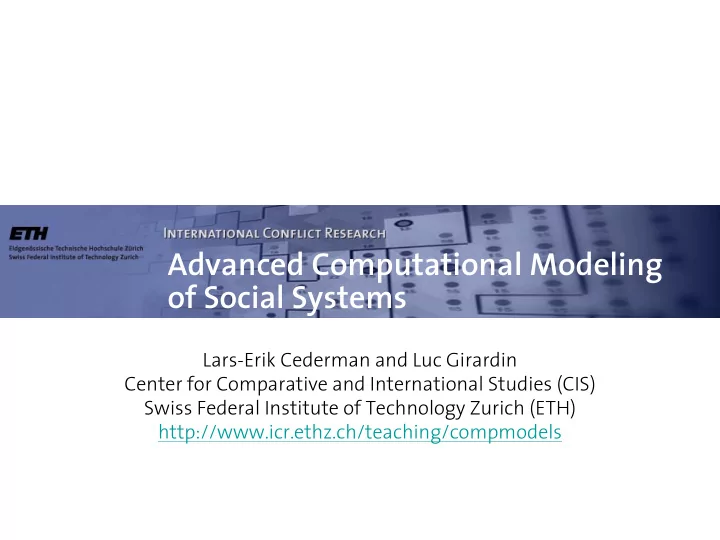

Advanced Computational Modeling of Social Systems Lars-Erik Cederman and Luc Girardin Center for Comparative and International Studies (CIS) Swiss Federal Institute of Technology Zurich (ETH) http://www.icr.ethz.ch/teaching/compmodels
Presentations 2 • 07.06.2005 III • Nicolas Bürkler (4) • 14.06.2005 III • Thomas Fent • 21.06.2005 III • Stephan Gammeter (2) • 28.06.2005 II • Jean-Luc Geering (1) • Jeremy Hackney (2) • Lutz Krebs (4) • Benjamin Lutz (1) • Charles Mitchell (3) • Gloria Müller (3) • Carsten Murawski (1) • Jonas Nart (3) • Nils Weidmann (2)
Computational Models of Social Forms ( AJS 2005) 3 • Putting agent-based modeling in a social- theoretic context: – Sociological process theory offers theoretical guidance for future modeling – Computational modeling helps process theorists craft better, more precise theories • Focus on research problems at the macro- level
Outline 4 Sociological Computational Process Theory Modeling Nomothetic Nomothetic theory modeling Epistemology Generative Generative theory modeling Variable-based Variable-based theory modeling Ontology Configurative Agent-based theory modeling
Sociological process theory 5 • Simmel: sociations or Vergesellschaftung • Chicago school: Mead et al • Elias’ “figurations” • Barth’s formal anthropology Norbert Elias Georg Simmel • Emirbayer’s “relationism”, Giddens’ “structuration”, Archer’s “morphogenetic” approach, Fararo’s “generative theory” George Herbert Mead
The epistemology of process theory 6 Sociological Compuational Process Theory Modeling Nomothetic Nomothetic theory modeling Epistemology Generative Generative theory modeling Variable-based Variable-based theory modeling Ontology Configurative Agent-based theory modeling
Toward generative theory 7 • Covering laws ==> uncovering mechanisms • Positivism ==> scientific realism • Abductive inference instead of induction or deduction: – making the puzzling less puzzling – metaphors, analogies, and simple models
The ontology of process theory 8 Sociological Computational Process Theory Modeling Nomothetic Nomothetic theory modeling Epistemology Generative Generative theory modeling Variable-based Variable-based theory modeling Ontology Configurative Agent-based theory modeling
Toward configurative theory 9 • A social form is a configuration of social interactions and actors together with the structures in which they are embedded. • Variables merely measure dimensions of social forms, not the forms themselves. • Social forms always have an extension in time and (geographic/abstract) space
The epistemology of computational modeling 10 Sociological Computational Process Theory Modeling Nomothetic Nomothetic theory modeling Epistemology Generative Generative theory modeling Variable-based Variable-based theory modeling Ontology Configurative Agent-based theory modeling
Toward generative modeling 11 • In Micromotives and Macrobehavior , Schelling invites the reader “to try to figure out what intentions, or modes of behavior, of separate individuals could lead to the pattern we observed.” • Axelrod: “a third way of doing science” • Epstein: “If you didn’t grow it, you didn’t explain it.”
Emergence 12 • Can be exhibited by generative processes • Emergent properties stem from the irreducibility of complex systems to the properties of their constituent parts • Usually due to non-linear interactions among system components • Bottom-up vs. intrinsic emergence
The ontology of computational modeling 13 Sociological Computational Process Theory Modeling Nomothetic Nomothetic theory modeling Epistemology Generative Generative theory modeling Variable-based Variable-based theory modeling Ontology Configurative Agent-based theory modeling
Toward agent-based modeling 14 • ABM features explicit representations of social forms. • Whereas variable-based modeling expresses causal relations among variables, ABM represents interactions among the actors directly. • Object-orientation facilitates the task of representing social forms.
Modeling Emergence 15 Four types of endogenous social forms: • Behavioral interaction configurations • Property configurations • Interactive networks • Actor structures
Emergent interaction patterns 16 • Models of “emergent order” producing configurations • Axelrod (1984, chap. 8): actor actor actor “The structure of actor actor actor cooperation” actor actor actor
Emergent property configurations 17 • Models of “emergent structure” constituted as property configruations • Example: Schelling’s segregation model; Carley 1991; Axelrod 1997 actor actor actor • See Macy & Willer 2002 actor actor actor actor actor actor actor actor actor for further references actor actor actor actor actor actor
Emergent networks 18 • Most computational frequency models treat networks as exogenous d - α • Recent exceptions: – Albert and Barabási’s scale- degree d free networks – Economics and evolutionary game theory: e.g. Skyrms and Pemantle
Emergent actors 19 • Computational models normally assume the actors to be given • Some exceptions: – Axelrod’s model of new political actors – Axtell’s firm-size model – Geopolitical models in the Bremer & Mihalka tradition • Emergence?
Conclusions 20 • ABM follows in the epistemological and ontological footsteps of sociological process theory • Future challenges of ABM: endogenization of networks and actor structures • Future challenges of process theory: clearer specification of generative theory that allows for systematic empirical anchoring.
The Luhmann Simulator 21 Prof. Dr. Uwe Schimank Fern Universität Hagen
Recommend
More recommend